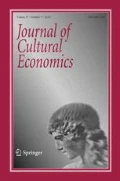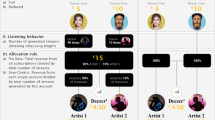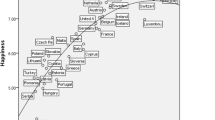Abstract
The arts in the USA receive little federal support relative to other developed nations. Because culture and the arts are often viewed as a nonessential role of government, public officials have proposed eliminating public funding for the arts. We examine support for public arts funding using a real-donation experiment (Eckel and Grossman in Games Econ Behav 16(2):181–191, 1996). Real-donation experiments combine elements of a controlled laboratory experiment with the context of a field experiment. In this “giving to the government” experiment, each participant allocates money between herself and a charitable organization supporting either cancer research, education, or the arts. There are two charities within each function: one is a private organization and the other a government agency. Not only do participants donate significant amounts to support the arts generally, we observe significant donations to a government agency that funds the arts. We find similar donation rates to cancer research and education as Li et al. (J Publ Econ 95(9–10):1190–1201, 2011), which provides a measure of external validity. Participants donate less to the arts than to cancer research or education and consistently give less to government organizations than to private charities. However, observing voluntary taxation to support the arts stands in striking contrast to current public policy. Significant predictors of giving include the perceived importance, efficiency, and trust of the organization, as well as gender. Our evidence suggests that current public funding for the arts may be less than optimal.

Similar content being viewed by others
Notes
The FY18 appropriation to the National Endowment for the Arts was less than 0.004 percent of total federal outlays (National Endowment for the Arts n.d.).
See the review by Kirchberg for an example of research on private arts donations (2003).
If any participant would have declined to act as monitor, the process would repeat until a monitor was selected. However, none declined the option to act as monitor.
Li et al. (2011) also vary the organizations by “level” from local, state, and national.
This was a different experimenter than the one tasked with reading instructions or who placed earnings in payment envelopes.
One could equally conjecture that participants believe they are expected to confirm economic theories such as free-riding, so perhaps participants feel compelled to give nothing.
See also Kessler and Vesterlund (2015).
Survey questions: How much do you trust the following organizations in providing [service]? To what extent do you agree or disagree that to provide [service] is the responsibility of the following organizations? How confident are you that donations to the following [service] organizations will be used efficiently?
In Session 2, participants could donate in honor or memory of someone. This option is not provided in Session 1. We find no significant difference in giving between sessions. Regression models include a treatment indicator for Session 2.
Cancer versus education: t = 3.37, p > 0.01; Wilcoxon signed-rank test, z = 3.20, p > 0.01. Education versus arts: t = 9.45, p > 0.01; z = 6.72, p > 0.01. All comparisons of importance remain statistically significant after Bonferroni corrections.
In real donation experiments with a charity as the recipient, females tend to be more charitable than males (Mesch et al. 2011).
We also estimate random effects probit models to investigate the likelihood of giving. Giving is more likely if the mission is important, the organization is trusted, or if the participant is female. Results and data are available upon request.
Minimal crowd-out may be a lower bound on the effect. Public funding may act as seed-money that may signal the organization is worthy of support. Public funding may then “crowd-in” additional private donations (see List and Lucking-Reiley (2002).
References
Americans for the Arts. (2018). Americans speak out about the arts in 2018: An in-depth look at perceptions and attitudes about the arts in America. https://www.americansforthearts.org/by-program/reports-and-data/research-studies-publications/public-opinion-poll.
Borgonovi, F., & O’Hare, M. (2004). The impact of the National Endowment for the Arts in the United States: Institutional and sectoral effects on private funding. Journal of Cultural Economics, 28(1), 21–36.
Brooks, A. C. (2001). Who opposes government arts funding? Public Choice, 108(3/4), 355–367.
Camerer, C. F. (2015). The promise and success of lab–field generalizability in experimental economics: A critical reply to Levitt and List. In G. R. Fréchette & A. Schotter (Eds.), Handbook of experimental economic methodology. Oxford: Oxford University Press.
de Quidt, J., Vesterlund, L., & Wilson, A. (2019). Experimenter demand effects. In A. Schram & A. Ule (Eds.), Handbook of research methods and applications in experimental economics. Cheltenham: Edward Elgar Publishing.
Eckel, C. C., & Grossman, P. J. (1996). Altruism in anonymous dictator games. Games and Economic Behavior, 16(2), 181–191.
Eckel, C. C., Grossman, P. J., & Johnston, R. M. (2005). An experimental test of the crowding out hypothesis. Journal of Public Economics, 89(8), 1543–1560.
Ho, J., Tumkaya, T., Aryal, S., Choi, H., & Claridge-Chang, A. (2018). Moving beyond P values: Everyday data analysis with estimation plots. https://doi.org/10.1101/377978.
Jones, K. (2017). Government or charity? Preferences for welfare provision by ethnicity. Journal of Behavioral and Experimental Economics., 66, 72–77.
Kessler, J., & Vesterlund, L. (2015). The external validity of laboratory experiments: The misleading emphasis on quantitative effects. In G. R. Fréchette & A. Schotter (Eds.), Handbook of experimental economic methodology. Oxford: Oxford University Press.
Kirchberg, V. (2003). Corporate arts sponsorship. In R. Towse (Ed.), A handbook of cultural economics. Northampton: Edward Elgar.
Levitt, S., & List, J. A. (2007). What do laboratory experiments measuring social preferences reveal about the real world. Journal of Economic Perspectives, 21(2), 153–174.
Lewis, G. B., & Brooks, A. C. (2005). A question of morality: Artists’ values and public funding for the arts. Public Administration Review, 65(1), 8–17.
Li, S. X., Eckel, C. C., Grossman, P. J., & Brown, T. L. (2011). Giving to government: Voluntary taxation in the lab. Journal of Public Economics, 95(9–10), 1190–1201.
Li, S. X., Eckel, C. C., Grossman, P. J., & Brown, T. L. (2015). Directed giving enhances voluntary giving to government: Implications for tax policy. Economics Letters, 133, 51–54.
List, J. (2007). On the interpretation of giving in dictator games. Journal of Political Economy, 115(3), 482–493.
List, J., & Lucking-Reiley, D. (2002). The effects of seed money and refunds on charitable giving: Experimental evidence from a university capital campaign. Journal of Political Economy, 110(1), 215–233.
Luccasen III, R. A. & Grossman, P. J. (2019). Taking aversion with earned endowments and tangible money. Monash University, Working paper.
Massey, C., & Thaler, R. (2013). The loser’s curse: Decision making and market efficiency in the National Football League draft. Management Science, 59(7), 1479–1495.
McGlone, P. (February 12, 2018). Trump’s budget eliminates NEA, public TV and other cultural agencies. Again. The Washington Post. https://www.washingtonpost.com/news/arts-and-entertainment/wp/2018/02/12/trumps-budget-eliminates-nea-public-tv-and-other-cultural-agencies-again/?utm_term=.781cef838e9c. Accessed 15 July 2018.
Mesch, D. J., Brown, M. S., Moore, Z. I., & Hayat, A. D. (2011). Gender differences in charitable giving. International Journal of Nonprofit and Voluntary Sector Marketing, 16, 342–355.
National Endowment for the Arts. (2000). International data on government spending on the arts. Research Division. Note #74. https://www.arts.gov/publications/international-data-government-spending-arts. Retrived July 15, 2018.
National Endowment for the Arts. (n.d.). Quick facts. https://www.arts.gov/sites/default/files/NEA_Quick_Facts_2018_V.1.pdf. Accessed 13 Jan 2020.
Newport, F. (2017). Americans’ confidence in institutions edges up. http://news.gallup.com/poll/212840/americans-confidence-institutions-edges.aspx. Accessed July 15, 2018.
Vesterlund, L. (2016). Using experimental methods to understand why and how we give to charity. In J. Kagel & A. Roth (Eds.), The handbook of experimental economics (Vol. 2). Princeton: Princeton University Press.
Zizzo, D. J. (2013). Experimenter demand effects in economic experiments. Experimental Economics, 13(1), 75–98.
Funding
We wish to thank Mississippi University for Women for financial support of this project.
Author information
Authors and Affiliations
Corresponding author
Ethics declarations
Conflict of interest
The authors declare that they have no conflict of interest.
Additional information
Publisher's Note
Springer Nature remains neutral with regard to jurisdictional claims in published maps and institutional affiliations.
Rights and permissions
About this article
Cite this article
Luccasen, R.A., Thomas, M.K. Voluntary taxation and the arts. J Cult Econ 44, 589–604 (2020). https://doi.org/10.1007/s10824-020-09376-2
Received:
Accepted:
Published:
Issue Date:
DOI: https://doi.org/10.1007/s10824-020-09376-2




